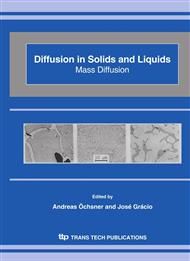p.91
p.101
p.107
p.113
p.118
p.124
p.130
p.137
p.146
Formation of Diffusion Potential Barrier for Oxygen Ions in Nio1-δ Crystal
Abstract:
A theoretical investigation of peculiarities in the formation of diffusion potential barrier for oxygen atoms in NiO1-δ crystal is performed. The approximation of pair interionic potentials set in analytical expressions is used for the evaluation of the potential barrier for the diffusing oxygen atom. It is shown that the potential energy of diffusing oxygen atom originates first of all from compensation between positive contribution of short-range interaction and negative contributions of the long-range Coulomb interaction. It is also influenced by effects of degenerate term splitting due to the low-symmetry crystal fields, created by the diffusing atom and vacancy, lattice relaxation and redistribution of excess charges in the vicinity of diffusing oxygen atom.
Info:
Periodical:
Pages:
118-123
Citation:
Online since:
October 2006
Keywords:
Price:
Сopyright:
© 2006 Trans Tech Publications Ltd. All Rights Reserved
Share:
Citation:


